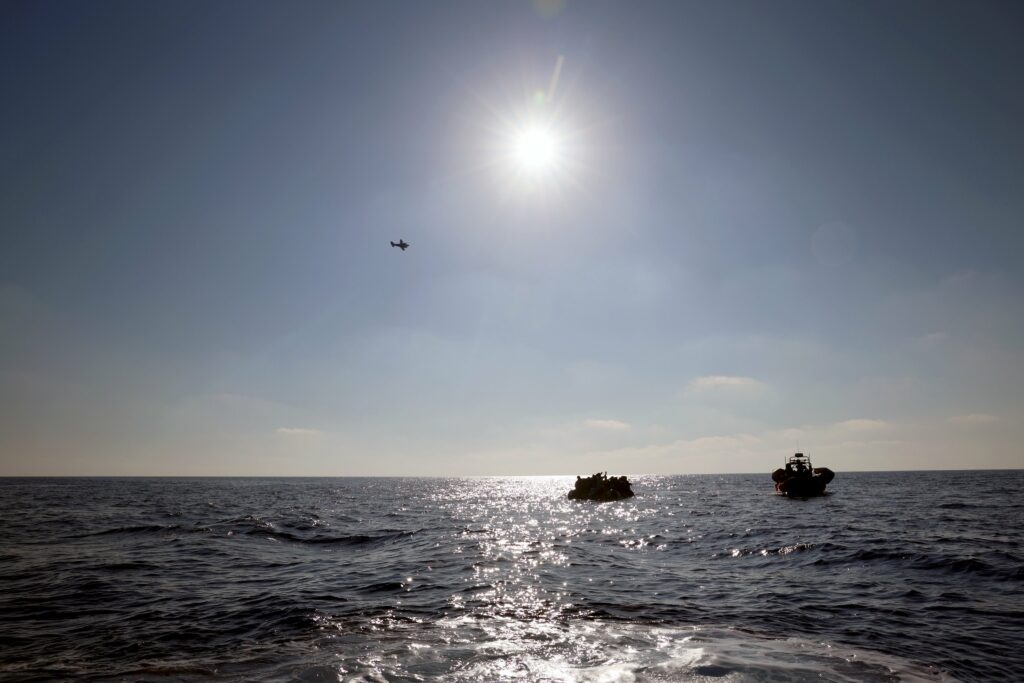
Chain of solidarity at sea. Source: MSF
Introduction
In the first half of 2024, Alarm Phone was alerted to 321 boats in distress in the central Mediterranean Sea. After the record year of 2023, when we were alerted to 1,203 cases, this marks a decrease in distress situations that reached our hotline.
This decrease also reflects an overall decrease in migratory crossings of the central Mediterranean Sea. While about 157,600 people succeeded in subverting Europe’s violent borders and reaching Italy by boat in the whole of last year, in the first half of 2024, 26,015 people managed to do so.
Over the first six months of 2024, it is estimated that about 800 people have died or disappeared and we know that the true figure is higher. It is estimated that about 30.000 people were forcibly returned to Tunisia by the Tunisian authorities and about 10,000 to Libya by the so-called Libyan coastguard, with continuous support by the EU and its member states.
Time and again, the chain of solidarity at sea – from our hotline to counter-monitoring aircraft and to the many rescue crews – has proven effective and resilient. According to the Civil Maritime Rescue Coordination Centre, of which Alarm Phone is a member, nearly 5,000 people were rescued until the end of June by the civil fleet.
In this analysis, we provide a comprehensive chronology of the first six months of 2024, offering in great detail an account of developments as they unfolded. As nobody else is doing so, we need to create our own archive of migrant struggles, acts of solidarity, and forms of border violence at sea.
Also in 2024, the year the Alarm Phone will turn 10 years old in October, we promise to continue in our struggle alongside people on the move. In our daily practice, we struggle against borders, for ferries, not Frontex, and the freedom of movement for all.
January
In January 2024, Alarm Phone was alerted to 28 boats in distress, among them 23 boats departing from Libya and five from Tunisia. NGO vessels rescued a total of ten boats that month – not all of them had alerted Alarm Phone. Two boats were rescued by merchant vessels. The Italian Coastguard rescued at least six boats – often when boats had almost reached Lampedusa. The Italian authorities also coordinated several rescue operations of boats heading towards Sicily or Calabria. In January, we also learned of at least eight interceptions by the so-called Libyan Coastguard and of one shipwreck.
On 2 January, Refugees in Libya reported of violent raids on migrant homes in Tripoli and the arbitrary detention of over 2,000 people at random checkpoints in Libya. Also a camp of Sudanese refugees in the vicinity of UNHCR Libya was evicted.
On 3 January, the Open Arms rescued two boats that were adrift with respectively six and 52 people on board. The former had alerted Alarm Phone.
On 4 January, media reports noted that Libya’s government (GNU) had expanded the authority of maritime borders from 12 to 24 nautical miles. This could mean that an NGO ship within this self-declared contiguous zone could be seized by Libyan patrol boats.
On 5 January, the Tunisian Guard National intensified patrols, conducting 13 operations, intercepting 188 individuals, and seizing ten iron boats. More expulsions to the desert along the Algerian border were reported.

Interception at sea by Tunisian National Guard. Source: @brirmijihed
On 6 January, after the disembarkation of the Open Arms in Salerno, two young Egyptian nationals, one 17 and the other 20 years old, were arrested and accused of having facilitated the illegal entry of their compatriots to Italy.
On 10 January, the Tunisian Forum for Economic and Social Rights (FTDES) called on the Tunisian government to end mass expulsions and arbitrary arrests of migrants and demanded a legal status for undocumented people in Tunisia. They denounced that the Tunisian National Guard was taking away the engines of refugee boats, leaving them adrift at sea. FTDES also accused the German government of complicity, as they had patrol boats to the Tunisian authorities.

Migrants in the desert. Source: infomigrants.net
On the same day, which marks the second anniversary of the brutal eviction of the protest in front of UNHCR Libya, Refugees in Libya invited to a two-day-long event in Bologna for the launch of a campaign to evacuate 221 human rights defenders who had been imprisoned for 18 months after participating in the protests in Libya.
On 11 January, 46 people who had alerted Alarm Phone were rescued by the merchant vessel Asso Trenta and brought to Lampedusa.
On the same day, the Geo Barents rescued 37 people from an overcrowded fiberglass boat off the Libyan coast and headed to Naples, the port assigned by the Italian authorities. Another boat in distress was illegally intercepted by the so-called Libyan Coastguard, with an asset that Italy had donated to them.
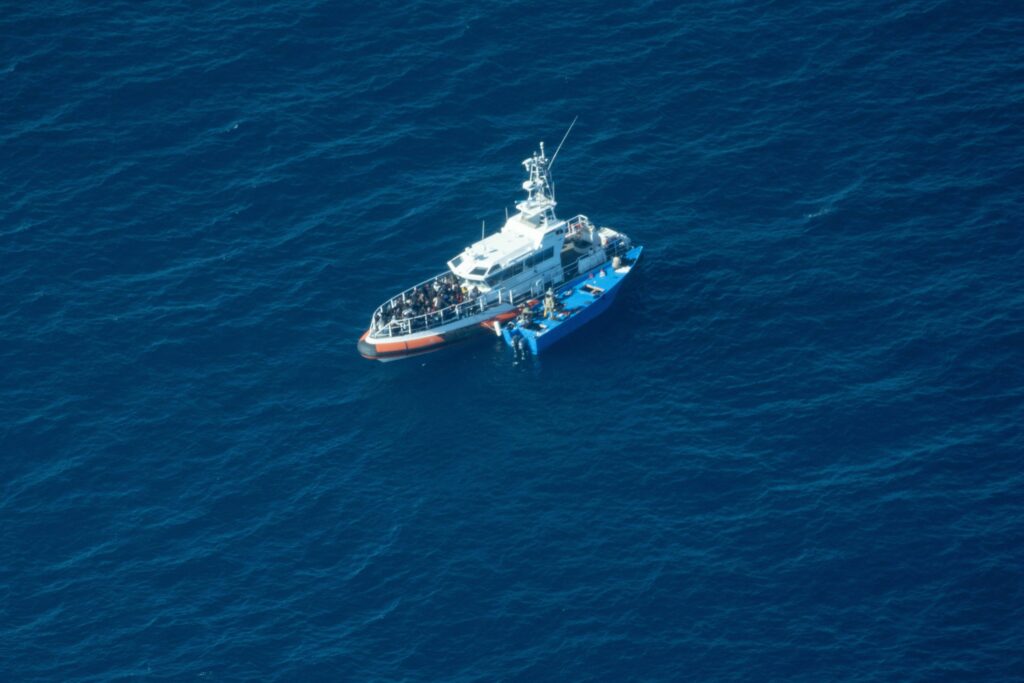
Photo of the interception of the boat in distress. Source: @seawatch_intl
On 12 January, Alarm Phone was alerted by a boat in distress carrying about 40 people travelling toward Lampedusa. We lost contact. The Italian authorities and Frontex eventually launched a search operation but it was ended four days later, without results. We do not know what happened to this group.
On 16 January, family members of 37 people on the move who had left on 11 January from Sfax, were protesting in Tunisia, asking the authorities to search for their children at sea. The Tunisian National Guard released a statement saying “all units” were mobilised to find them. But family members in El Hancha, where the people on the boat came from, complained about the continued absence of information about the lost boat.
On 17 January, a group of about 30 people alerted Alarm Phone. We informed authorities and later learned that they were found and rescued to Lampedusa by the Italian Coastguard. Due to bad weather, only one other landing of 50 people was reported.
On 18 January, the Humanity 1 rescued 126 people in distress at sea on an overcrowded wooden boat in international waters. The distress case had been reported by Alarm Phone and also a Frontex airplane.
On 19 January, the Humanity 1 was assigned Ortona as a place of safety, 1,200 km away with bad weather expected.
On 20 January, Alarm Phone was in contact with people on a boat in distress south of Crete, who had left from eastern Libya. The Greek Coastguard refused to take any responsibility and said the Libyan authorities were responsible. We learned that, eventually, the 36 people were rescued by the merchant vessel LIDER HALIL to Crete.
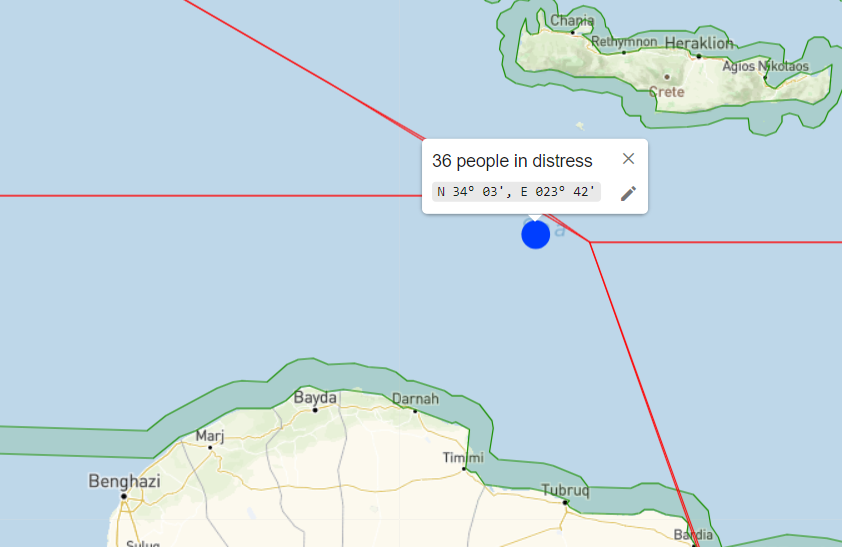
Map showing the position of the boat in distress. Source: Alarm Phone
On 23 January, we learned that thanks to the abolition of Law 2015-036 by the government of Niger, it is now once again possible for everyone to use the official migratory routes and stop at the wells without fear of being checked or detained.
On 25 January, 68 people in distress were rescued by the Geo Barents from three unseaworthy fiberglass boats in international waters. They had been spotted from the bridge, but had also alerted Alarm Phone. The Geo Barents was assigned the faraway port of Genova.
On the same day, a shipwreck was reported off the Sicilian coast – at least one of the about 80 people on board died.
On 27 January, Alarm Phone was in contact with people in distress, trying to escape from Libya. Six of the people were taken out of the water and onto the merchant ship MARIDIVE and probably brought to Libya. The remaining 42 people on the boat were able to continue their journey and finally rescued with the help of the civil fleet and brought to Lampedusa by the Italian Coastguard.
On 29 January, the Albanian Constitutional Court gave green light for the deal to detain in people, including asylum seekers rescued at sea by Italian ships, in detention camps in Albania.
On 30 January, the Sea-Watch 5 rescued 50 people in distress at sea and got Civitavecchia assigned as port.
On 31 January, the Humanity 1 was approached, without warning, by a Libyan patrol boat at full speed and on a collision course. The patrol boat crossed its bow, and then threateningly circled around the NGO rescuers for several minutes.
On the same day, details were reported on the deal currently in negotiation between the EU and Egypt. The deal, formally known as an Anti-Smuggling Operational Partnership, attempts to curb irregular migration to the EU.
February
In February, Alarm Phone was alerted to 36 boats in distress, among them 30 departing from Libya, three from Tunisia, one from Algeria, one from Egypt and one from Lebanon. NGO vessels rescued a total of ten boats that month – not all of them had alerted Alarm Phone. One boat was rescued by a merchant vessel to Crete. The Italian Coastguard rescued some boats near Lampedusa. We know of 21 interceptions by the so-called Libyan Coastguard and of five shipwrecks in February.
On 1 February, the Humanity 1 rescued 64 people in distress. During their 1,200 km journey to the assigned port of Marina di Carrara, the crew found another dinghy with about 40 people on board and provided them water and life jackets until the arrival of the Italian Coastguard, which led them to Pantelleria.
On the same day, a boat capsized off Lampedusa. The Italian Coastguard rescued 49 people, others went missing. They had left from Al Amra, Tunisia.
On 2 February, Alarm Phone was in contact with a group of about 125 people in distress who had escaped Libya. They were intercepted and illegally forced back to Libya.

Map showing the position of the intercepted boat. Source: Alarm Phone
The night before, Alarm Phone had alerted authorities to a group who had escaped Libya in a rubber boat. They were only able to move on slowly, given the worsening weather. The so-called Libyan Coastguard told us that they had sent out a ship but did not find the people. On 4 February, a relative of a person on board the boat informed us that the group had managed to return to Libya on their own.
On 4 February, Alarm Phone was contacted by 25 people at risk off Benghazi. We alerted authorities and a merchant vessel close by. But we never reached the people again and don’t know what happened to them.
On 5 February, the Geo Barents rescued 134 people from an overcrowded double deck wooden boat, following a distress alert by Alarm Phone.
On 6 February, the Ocean Viking performed a complicated rescue operation of 110 people who had alerted Alarm Phone in the middle of the night off the coast of Libya. The so-called Libyan Coastguard approached the rescue area, then left the scene after a few minutes.
On the same day, 105 people called Alarm Phone in fear of drowning. Authorities in Tunisia and Malta refused responsibility and we lost contact to the people. According to several relatives, the Tunisian Coastguard intercepted the group, but the Tunisian authorities denied that.

Map showing the position of the intercepted boat. Source: Alarm Phone
On 8 February, a shipwreck off Tunisia was reported. 13 bodies were recovered, at least 27 people went missing.
On 9 February, Alarm Phone alerted authorities about a group who reported high waves and water entering the boat. The Tunisian Coastguard said they were not able to reach the boat due to bad weather. On the next day, we learned that the 55 people had been rescued to Lampedusa.
On 10 February, the Ocean Viking was detained in Italy, facing false declarations made by Libyan actors. It was the third detention in three months.
On 15 February, a boat carrying 54 people who were fleeing from Libya sank off the coast of Zarzis, Tunisia. The Tunisian National Guard confirmed that five bodies were recovered, one person was in serious condition. 48 survivors were taken to an undisclosed location.
On 16 February, the highest Italian court confirmed that handing over people on the move to the so-called Libyan Coastguard was illegal, given that Libya could not be considered a safe port. The merchant ship ASSO 28 had handed over 101 people to a Libyan patrol boat in 2018 and the captain was sentenced to one year in prison.
On 18 February, the Geo Barents rescued over 80 people during two critical rescue operations. One person was found dead, another one passed away on the Geo Barents and three people went missing. One of the boats had alerted Alarm Phone, 19 of the people who were rescued had managed to swim to an oil platform.
On 19 February, 37 people on an overcrowded fiberglass boat, who had been at sea for at least four days, called Alarm Phone and were rescued by the Geo Barents, while on its way to Bari.
On 20 February, a judge in Brindisi suspended the administrative detention of the Ocean Viking and declared the measures issued by the Italian government blocking humanitarian ships as illegitimate.
On 22 February, 22 organisations published a joint statement against the Italian law hindering NGO SAR activities.
On 23 February, 16 people who had left from the west coast of Oran, Algeria, four days earlier, went missing. Relatives lost contact and authorities did not provide information.
On the same day, five people on the move died off Malta. The boat carrying at least 34 people capsized during a rescue operation by the Armed Forces of Malta (AFM). Maltese organisations demand a comprehensive and public inquiry into this loss of lives.
On 24 February, Alarm Phone alerted authorities about a boat drifting off the coast of Egypt, on its way to Crete. According to media reports, the 35 people were rescued south of Iraklion, Crete.

Map showing the position of the drifting boat. Source: Alarm Phone
On 25 February, a boat alerted Alarm Phone between Libya and Crete. The approximately 100 people were rescued to Crete by a merchant vessel.
On 26 February, the first anniversary of the Cutro shipwreck, survivors and relatives of the victims gathered at the site where a migrant vessel had capsized on 26 February 2023 off the Calabrian coast. 94 people died because Frontex and Italy failed to rescue them.
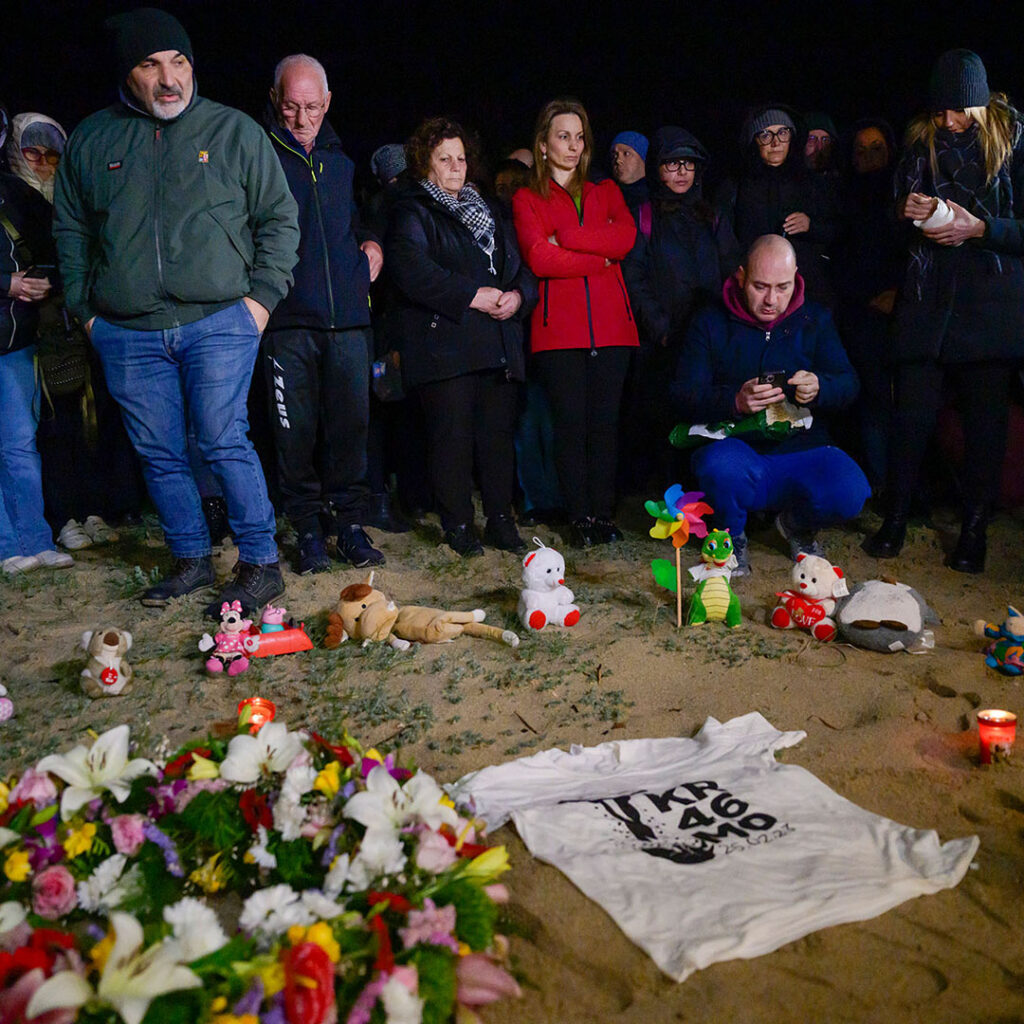
Commemoration at the coast of Cutro. Source: @infomigrants
On 27 February, the Sea-Watch 5 rescued 45 people from an unseaworthy boat. This time, they were assigned Catania for disembarkation – a relatively nearby port in Sicily.
On 28 February, the SeaEye4 rescued 57 people in Maltese SAR and recovered two corpses. Alarm Phone was alerted by this group fleeing Libya.
On the same day, the prosecutor in Trapani asked to drop all charges against Iuventa, the seemingly never-ending case where civil rescuers were cynically criminalised by the Italian authorities.
March
In March, Alarm Phone was alerted to 62 boats in distress, among them 45 departing from Libya, 17 from Tunisia. At the same time, we know of about 40 other boats that left from Tunisia, most of them arriving in Lampedusa. NGO vessels rescued a total of 15 boats that month – not all of them had alerted Alarm Phone. One boat was rescued by a merchant vessel to Egypt, a second one to Lampedusa. The Italian Coastguard rescued two boats of which we know. Often, they rescued boats when they had almost reached Lampedusa, and they also coordinated some rescue operations of boats heading towards Sicily or Calabria. One boat was rescued by the Greek Coastguard to Crete. We know of 39 interceptions by the so-called Libyan Coastguard and at least eight by the Tunisian Coastguard, but there were many more, as the Tunisian authorities have stated themselves. We were informed about two shipwrecks in March.
On 2 March, a rescue mission of the Humanity 1 in international waters faced an intervention by the so-called Libyan Coastguard. During the rescue operation, a Libyan patrol boat arrived, fired live bullets at the water and threatened the crew of the Humanity 1. The crew nevertheless managed to rescue 77 people, but at least one person died. Some people were forced onto the patrol boat and returned to Libya. Seabird spotted this case and another interception by the same Libyan boat. Also in this case, people went overboard.

Photo of the interception, spotted by Seabird. Source: @seawatch_intl
On 3 March, the so-called Libyan Coastguard intercepted a boat carrying 88 people who had alerted Alarm Phone off Garabulli. All were forced back to Tripoli.
On 4 March, the Sea-Watch 5 rescued 70 people in two operations. Reggio Calabria was assigned as port of safety, but because of four-meter-high waves, the ship had to seek shelter in Lampedusa.
On 5 March, the first 97 of 1,500 refugees and people in need of international protection were evacuated from Libya to Italy. This humanitarian corridor is the result of an agreement between the Italian government, Sant Egidio, the Federation of Evangelical churches, and other actors.
On the same day, when 77 survivors were disembarked in Crotone, the Humanity 1 was detained again by the Italian authorities, based on false accusations concerning the intervention of the so-called Libyan Coastguard on 2 March.
Also on the same day, the trial against two young men accused of hijacking the El Hiblu 1, an oil tanker, started in Malta, following nearly five years of investigation. Another court case on the Easter massacre in 2020 was dismissed on procedural matters. Survivors of a violent Maltese pushback to Libya via the fishing vessel Dar al Salaam had filed the case.
On 6 March, the Sea-Watch 5 urgently called for medical evacuations for four persons. Only nine hours later, the Italian Coastguard took them while refusing to take the 17-year-old who had died on board. Only on 8 March, the Sea-Watch 5 could disembark him and 51 survivors in Pozzallo.
On 7 March, 84 people, who had called Alarm Phone when escaping Libya, were rescued by the Seaeye4. The crew reported having been attacked by the so-called Libyan Coastguard.
On 8 March, according to media reports, more than 250 people had arrived in Lampedusa during the hours before. 46 people were rescued from rocks at the western point of the island.
On 9 March, the Sea-Watch 5 was detained by the Italian authorities for twenty days. They announced to challenge the measure in court.
On the same day, the Life Support asset was denied the possibility of intervening to help 40 shipwrecked people who had arrived on the Tunisian gas platform MISKAR.
On 11 March, 52 people who alerted Alarm Phone when fleeing from Libya were rescued by the Life Support.
On the same day, the Seaeye4 was detained for 60 days after the rescue of 202 people. This was the third detention of a German rescue ship within a few days and the longest one since the Piantedosi Decree came into force.

Photo of the NGO vessel SeaEye 4. Source: @gorden_isler
On 12 March, the joint mission of Open Arms and WCKitchen set sail from Cyprus and headed to Gaza loaded with 200 tons of food. Alarm Phone declared its solidarity with them, denouncing the Israeli occupation and the atrocities committed against the people of Palestine.
On 13 March, the Ocean Viking evacuated 25 people from a drifting boat. According to testimonies, the people had spent approximately a week at sea. It was probably a boat that had alerted Alarm Phone on 9 March. The so-called Libyan Coastguard had claimed that they could not find them. We had lost contact to the boat, which had initially carried about 85 people.

Last known position of the drifting boat. Source: Alarm Phone
On 14 March, 56 people who had alerted Alarm Phone were assisted by the sailing ship Trotamar III in Maltese SAR and finally rescued by the Italian Coastguard.
On 15 March, the Tunisian National Guard found a boat with 34 survivors and two dead people off Zarzis. Investigations revealed that the boat from Libya had initially carried about 70 people.
On 16 March, more than 900 people arrived in Lampedusa since the evening before.
On the same day, the Geo Barents witnessed a pushback of over 100 people by Libyan forces only 40 nautical miles off Lampedusa. The crew of the Geo Barents was threatened by a Libyan patrol boat during a rescue operation in international waters.
On 17 March, 75 people who had alerted Alarm Phone were rescued by the Geo Barents in a difficult operation, during which 45 people fell overboard. Luckily, everyone could be rescued.
On the same day, the Life Support rescued 71 people from a wooden boat, who had alerted Alarm Phone when trying to escape from Libya.
On 18 March, 371 people arrived on a fishing boat in Pozzallo, escorted by Italian Coastguard. They had probably left from Libya.

Photo of the overcrowded fishing boat. Source: @giadadrocker
On the same day, media reported that the EU and Egypt had just signed a €7.4 billion “comprehensive partnership” agreement to inject fresh funds to help stabilise a wobbly economy and curb flows of irregular migration.
Also on 18 March, the illegitimate detention of #Humanity1 was lifted! The civil court in Crotone cited “the apparent injustice of the measure issued” as the reason for the preliminary, positive decision in a fast-track appeal.
On 21 March, the MSF ship Geo Barents received a 20-day detention order from the Italian authorities, allegedly failing to comply with the so-called Libyan Coastguard instructions during a rescue operation on 16 March. MSF announced they would appeal against this detention.
On the same day, the Mare*Go assisted people in distress who had been at sea for four days and had alerted Alarm Phone.
On 23 March, over 600 people landed at Lampedusa during the night on 13 boats. They had departed from Tunisia and Libya. A 15-months-old girl went missing after a boat capsized.
On the same day, Tunisia’s National Guard in Sfax published that they intercepted 1,351 individuals during the past four days, discovering four deceased people.
On 24 March, the Mare Jonio rescued 114 people in two operations. 59 of them had alerted Alarm Phone when trying to escape from Libya.
On 25 March, we learned that the merchant vessel VAULT had rescued 158 people from a boat that had alerted Alarm Phone the day before. Several people went over board, three remained missing. The survivors were disembarked in Lampedusa.

The merchant vessel VAULT at the position of the rescue. Source: vesselfinder.com
On 26 March, the GAMMA STAR, together with another merchant vessel, rescued a boat, carrying about 160 people who had alerted Alarm Phone from Egyptian SAR south of Crete. They wanted to disembark in Greece, but were denied permission. On 27 March, they arrived at Port Said. Egypt is not a safe place for these people!
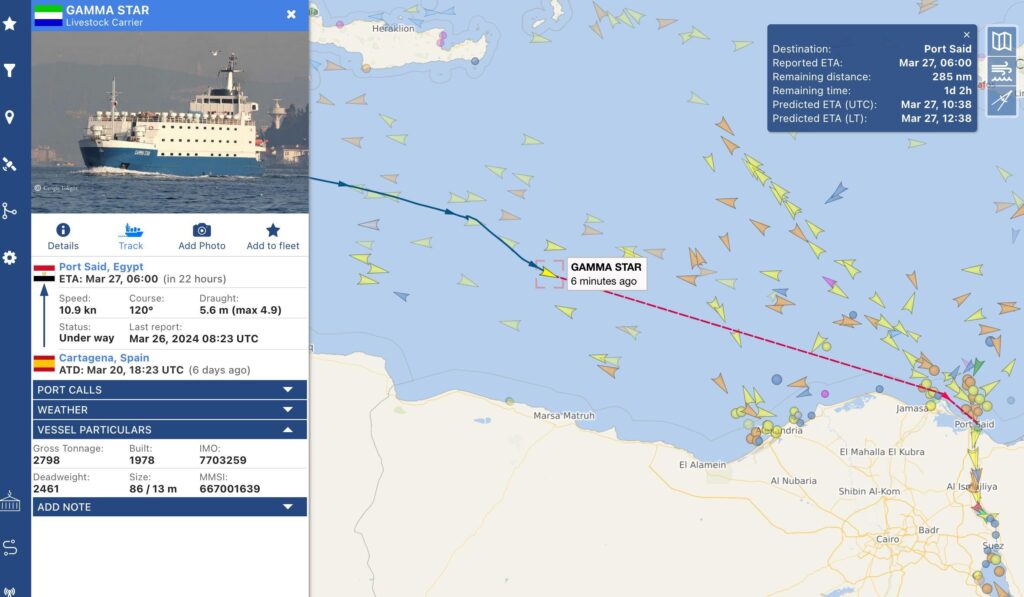
Track of the merchant vessel GAMMA STAR. Source: vesselfinder.com
On 29 March, the TROTTAMAR III discovered a shipwreck off the coast of Lampedusa. They could rescue 31 people, but three people probably drowned.
On the same day, the detention of the Sea-Watch 5 was suspended! The court in Ragusa could not find any unlawful behaviour.
April
In April, Alarm Phone was alerted to 66 boats in distress, among them 25 departing from Libya, 34 from Tunisia. We also know of about 60 other boats that left from Tunisia, most of them arrived in Lampedusa. Two boats left from Lebanon. The place of departure of four boats is unknown. As several NGO vessels were detained in April, the Civil Fleet rescued only five boats that month – not all of them had alerted Alarm Phone. A group on one boat was rescued by a merchant vessel but then forced back to Libya. The Italian Coastguard rescued at least four boats that we know of – often when boats had almost reached Lampedusa. The Italian authorities also coordinated several rescue operations of boats heading towards Sicily or Calabria. We know of ten interceptions by the so-called Libyan Coastguard and more than 80 operations by the Tunisian Coastguard. We were informed about five shipwrecks in April, all occurring off the Tunisian coast, and one in the Maltese SAR zone.
On 2 April, the Ocean Viking was alerted by Seabird to a boat carrying 15 people in distress in the Libyan SAR. A Libyan patrol boat intercepted the boat.
On 3 April, maritime units of the Tunisian Guard National carried out 31 operations, intercepting 1,335 individuals of Sub-Saharan-African nationalities. They all face the risk of expulsion to the desert or kidnapping for ransom by criminal networks.
On 4 April, a patrol boat of the so-called Libyan Coastguard intervened violently in the rescue operation of a boat in distress by the Mare Jonio in international waters. Despite gunfire from officers on the Libyan patrol boat, 58 people could be taken on board of the NGO vessel and were brought to Pozzallo.
On 5 April, a shipwreck happened off Sfax. 50 people were rescued by the Tunisian National Guard, 28 went missing. During the previous three days, 1,865 people arrived in Lampedusa, mainly from Sfax.
On 6 April, the Mare Jonio was notified by the Italian authorities of the provision of a fine of up to 10,000 € and administrative detention for 20 days on the basis of false accusations by the so-called Libyan Coastguard. The commander of the Mare Jonio wrote in a statement on 9 April: “It is a shame that my country’s government funds and supports these criminals. The reconstruction of the so-called Libyan authorities is completely false. We will demonstrate it in the competent offices.”
Also on 6 April, 70 people alerted Alarm Phone in distress in international waters. The supply ship MARIDIVE 704 rescued them but handed them over to the so-called Libyan Coastguard who forced them back to Libya.
On the same day, units of the Tunisian Guard National conducted 55 operations near Sfax, intercepting 1,867 people. Also 13 bodies were found, victims of an invisible shipwreck.
On 7 April, about 30 people who called Alarm Phone in distress in Maltese SAR were able to move on to Sicily and eventually rescued by the Italian Coastguard. Also a group of 22 people who alerted Alarm Phone arrived in Sicily. In total, 136 people were rescued that day to Italy.
On 8 April, 83 people who had alerted Alarm Phone on a boat adrift in Maltese SAR, were illegally intercepted by the so-called Libyan Coastguard and forced back to Libya. Some days later, 22 organisations called on Malta to stop pushing back people at sea to the North African country.
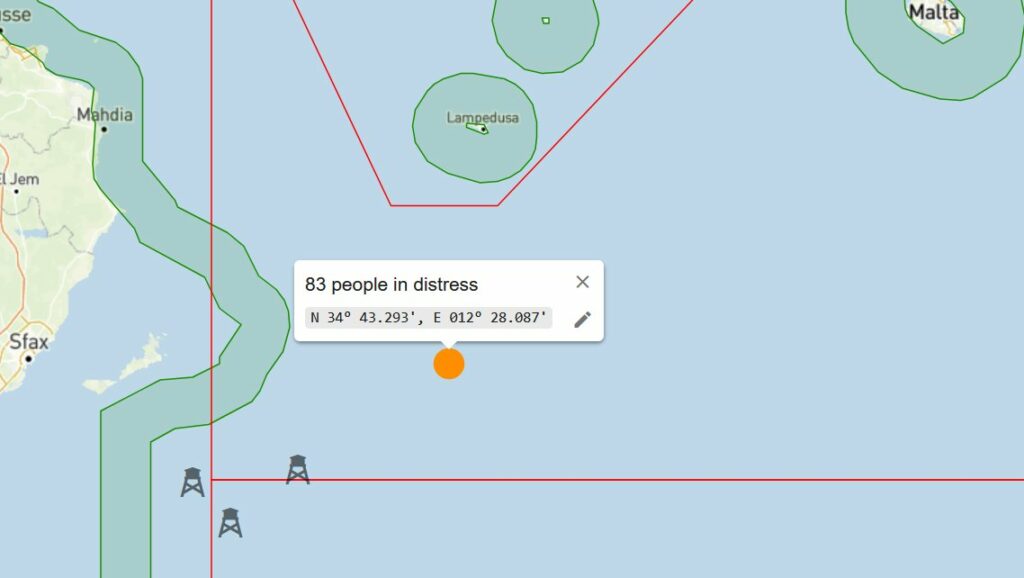
Map showing the position of the intercepted boat. Source: Alarm Phone
On 9 April, Alarm Phone joined associations in Tunisia and beyond to condemn the systematic violence and racist campaigns targeting Black people in Tunisia.
On 10 April, the EU Parliament voted on the New Pact on Migration (CEAS/GEAS) which further escalates brutal migration controls and abolishes the right to asylum in practice.

Protest against CEAS / GEAS in Germany. Source: Alarm Phone
On the same day, a shipwreck in Maltese SAR happened. 25 people survived, nine people, among them a little girl, died.
On 12 April, a report from Agadez showed that people on the move were returning to this city since the government of Niger abolished the anti-migration law last November.
On 13 April, Alarm Phone joined a ceremony in Malta, where the El Hiblu3 received the Human Rights Defenders Award for resisting a pushback to Libya.
On 15 April, Sea-Watch denounced an illegal interception of a highly overcrowded rubber boat by the militias of the so-called Libyan coastguard. A nearby merchant vessel offered help, but the militias arrived first to force the people back to Libya.
On the same day, Italian media reported that the announced camps in Albania for people rescued at sea would not be ready before November 2024. On 16 April, a health official in Tunisia’s coastal region of Sfax said that the number of drowned migrants had exceeded the capacity of the region’s hospital mortuary, which can take 35 corpses. There were around 100 bodies, awaiting burial.
On 18 April, around 400 people on the move who had camped outside the IOM office in Tunis already for almost a year, demanded: “Evacuation is all we need out of Tunisia! Our lives are at risk”.
On 19 April, there was the last hearing of the Iuventa pre-trial. The judge in Trapani dropped all charges against the Iuventa crew.
On the same day, the Civil Court of Crotone confirmed the lift of the detention of Humanity 1 in March 2024. The court emphasised that the crew of the Humanity 1 rescued people in accordance with the law, while the so-called Libyan Coastguard had endangered lives.
On 20 April, the Court of Crotone confirmed the suspension of the Ocean Viking arrest (see 20 February). During the two hearings, the possible unconstitutionality of the Piantedosi decree regulating the management of rescue at sea was also discussed.
On the same day, an invisible shipwreck was discovered near Sfax. The Tunisian National Guard recovered 19 bodies.
On 24 April, the National Guard of Tunisia recovered bodies from two other invisible shipwrecks, 14 near Djerba and seven near Gabes, South Tunisia.
On 26 April, the crew of Sea-Watch 5 rescued 47 people from an unstable dinghy and headed for the harbour in Catania, Sicily.
On 30 April, reports on the deteriorating situation of people on the move in Tunisia emerged. Police forces were dismantling the camps set up between Sfax and Jbeniana and since autumn, kidnappings to extortions have increased.
May
In May, Alarm Phone was alerted to 64 boats in distress, among them 53 departing from Libya, 11 from Tunisia. We also know of 24 other boats that left from Tunisia, most of them arrived in Lampedusa. NGO vessels rescued 13 boats that month – not all of them had alerted Alarm Phone. One boat was rescued by a merchant vessel to Crete, a second one to Lampedusa. The Italian Coastguard rescued at least nine boats that we know of – often when boats had almost reached Lampedusa. The Italian authorities also coordinated several rescue operations of boats heading towards Sicily or Calabria. We know of 19 interceptions by the so-called Libyan Coastguard and many more by the Tunisian Coastguard. We were informed about four shipwrecks in May.
On 1 May, the Geo Barents rescued 52 people from a wooden boat in distress and headed toward Bari, the place of safety assigned by the Italian authorities.
On 2 May, a group of about 45 people on the way from eastern Libya to Crete was rescued by a merchant vessel and then taken onboard a Greek Coastguard ship.
On the same day, Rome hosted a meeting of the interior ministers of Tunisia, Libya, Algeria and Italy, where they discussed how to combat “illegal flows of migration”.
On 3 May, at approximately 3am, Tunisian police forces dismantled the protest camp outside the UNHCR and IOM offices in the Lac zone of Tunis. Hundreds of people were arrested and forcibly put on busses bound for the Algerian border.
On 5 May, after weeks without arrivals, several boats reached Lampedusa from Tunisia and Libya with about 300 people disembarking at the Favaloro pier. Among them was a group supported by the Nadir and another one by the new civil boat Maldusa.
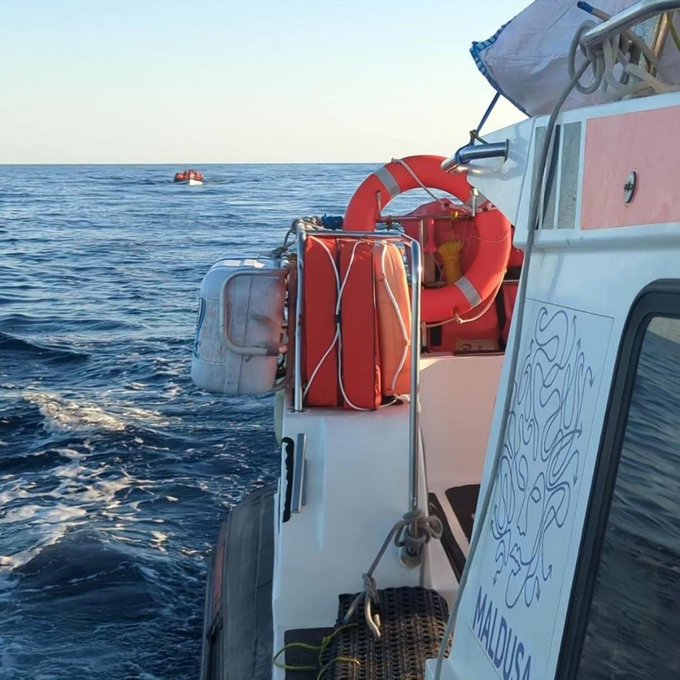
Photo of the MALDUSA boat. Source: @Maldusa_Project
On 5 May, survivors reported that the Tunisian National Guard had capsized a boat of 42 people. 16 of them drowned. The National Guard conducted 22 operations that night near Sfax, intercepting over 600 individuals. On land, 20 Tunisians were arrested and several boat workshops were raided.
On 7 May, Byron Camilleri, Home Affairs Minister of Malta, met with eastern Libya’s government of Haftar and they agreed to cooperate more closely in „training, fighting human trafficking and other criminal activities“.
On the same day, Saadia Mosbah, a prominent activist and head of an NGO that defends the rights of migrants, was detained in Tunisia. Also other NGOs accused of defending Black people on the move and receiving money from other countries were attacked by the Tunisian government. Their members were arrested and offices searched.
On 9 May, Tunisian activists protested at the EU mission headquarter in Tunis against the border violence, sponsored by the EU, and the wave of arrests and deportations.

Protest at the EU mission headquarter in Tunis. Source:@brimijihed
On the same day, the Greek Coastguard confirmed the rescue of 47 people who had alerted Alarm Phone in distress on the way from eastern Libya to Crete.
On 10 May, we learned that 31 people in distress east of Sicily who had called Alarm Phone were rescued by the Italian Coastguard to Augusta.
On 11 May, raids and arrests in Tunisia continued, even of lawyers and journalists. Also more deportations of people on the move to the Algerian border took place.
On 12 May, Alarm Phone Tunis published a statement on the situation in Tunisia and the role of the EU: “Against all odds: European states pursue border outsourcing policies in Tunisia”.
Between 11 and 12 May, many landings to Lampedusa took place: 355 people arrived, eight boats from Tunisia, two from Libya. But also interceptions happened by the so-called Libyan Coastguard and the Tunisian National Guard.
On 14 May, the Aurora assisted 51 people on two boats in distress who had alerted Alarm Phone. Eventually, the Italian Coastguard brought them to Lampedusa.
On 15 May, the Nadir found an overloaded fiberglass boat with broken engine and 33 people aboard who had called Alarm Phone. Authorities asked the Nadir to take the people on board and bring them to a port of safety.
On 16 May, the Tunisian bar association accused policemen of torturing a lawyer during detention. Amnesty International denounced the repressive crackdown on Tunisian NGO workers following months of escalating violence against people on the move. 60 Black persons were sentenced to eight months in prison for illegal entry, unlawful residence and “disturbing public order”.
On the same day, Humanity 1 rescued two boats in distress. Both cases were alerted by Alarm Phone. Italian authorities assigned again a distant port for disembarkation.
On 17 May, we learned that the merchant vessel ATHENS VOYAGER had rescued 21 people who had alerted Alarm Phone south of Crete and brought the people to Egypt, the place they had tried to escape from.
On 20 May, the Ocean Viking, after an alert from Alarm Phone, found and rescued a fiberglass boat with 35 people on board in the shared Maltese/Italian SAR zone. The people had spent three nights at sea.
On 21 May, charges were dropped against nine Egyptian survivors of the Pylos shipwreck that took place on 14 June 2023 off Greece, where more than 600 people died. The Greek court said it had no jurisdiction as disaster happened in international waters. Even after the acquittal, the authorities decided to keep the nine persons in administrative detention.
On the same day, a report by Lighthouse, Washington Post and Spiegel documented how North African countries push people on the move to the desert, with Europe’s support. The investigation focused on Tunisia, Morocco and Mauritania.
On 23 May, we learned that the merchant vessel JULIET rescued 40 people, who alerted Alarm Phone when fleeing Libya, and took them to Crete. Sadly, one person drowned during the rescue operation.

Map showing the position of the boat, later rescued by the JULIET. Source: Alarm Phone
On 24 May, the Nadir, supported by Alarm Phone, found a boat carrying 42 people. As bad weather increased the risk of capsizing, the small Nadir took the people on board and brought them to Lampedusa.
On 27 May, the Humanity 1 rescued two boats alerted by Alarm Phone, one carrying 18, the other 82 people.
On 28 May, the Humanity 1 crew discovered two boats in distress. On one of the boats, a dead baby was found, who had died from malnutrition under the inhuman conditions in Tunisia from where the boat had left.
On 28 and 29 May, 700 people arrived in Lampedusa within 48 hours.
On 29 May, the Nadir was alarmed to an overcrowded metal boat with 45 people on board. Panic broke out when they boarded the Italian Coastguard ship but everyone was rescued and brought to Lampedusa.
On 30 May, the court in Malta decided that the trial against the El Hiblu 3 would continue. Alarm Phone and many other supporters demand the dropping of charges against these brave people who had prevented a pushback to Libya.
On the same day, Alarm Phone Sahara reported that nine people had died in Assamaka at the Niger-Algerian border between 10 and 13 May after deportation from Algeria.
On 31 May, 49 people who had alerted Alarm Phone in the Sicilian Channel were rescued by the Italian Coastguard to Pozzallo.
On the same day, Alarm Phone was alerted by 60 people in a rubber boat south of Malta who had left from Garabulli, Libya. One day later we learned from a relative that the people were rescued by a merchant vessel (the tanker Maersk Agean) and brought to Lampedusa. Sadly, we were told that one person died during the rescue.
June
In June, Alarm Phone was alerted to 65 boats in distress, among them 58 departing from Libya, five from Tunisia, one from Algeria and one from Turkey. NGO vessels rescued 20 boats that month – not all of them had alerted Alarm Phone. One boat was rescued by a merchant vessel to Lampedusa. The Italian Coastguard rescued around 50 boats of which we know, most of them close to Lampedusa. We know of 18 interceptions by the so-called Libyan Coastguard and a lot by the Tunisian Coastguard. We were informed about three shipwrecks in June.
On 1 June, an event organised by Refugees in Libya took place in Rome with the presence of seven Human Rights Defenders evacuated from Libya to Italy on 7 May. It was a successful follow-up of the kick-off event for an evacuation campaign in Bologna in January.
On 3 June, media reports stated that the centres in Albania which Italy wants to build to detain people rescued at sea would not be ready before mid-September. According to Giorgia Meloni’s plans, the centre should have already been opened, just in time for the final stages of the EU election campaign. A contract for the rental of a private ship to transport the migrants would cost 13.5 million Euro.
On 5 June, the court in Reggio Calabria ruled in favour of Sea-Eye’s lawsuit and declared the 60-day detention of the Sea Eye 4 in March 2024 to be unlawful. The judge found the allegations that the crew of the ship had not followed the instructions of the so-called Libyan coastguard to be unproven.
On the same day, 89 people on the move landed in Crotone. They were aboard a yacht and rescued by the Italian Coastguard.
On 6 June, the German taz reported that thousands of people on the move were being held in camps near the Tunisian coastal town of Sfax. The camps north of Sfax were apparently to be closed and the migrants deported to Niger as part of an alliance forged with Algeria and Libya. Alarm Phone Sahara counted 4,428 people who were deported already in May 2024, and reported several deaths.

Photo of a deportation to the border between Algeria and Niger. Source: @AlarmphoneS
On 7 June, the Geo Barents carried out two rescue operations in the Libyan SAR and was assigned Civitavecchia as place of safety. But they went back to recover 11 bodies spotted by Seabird, probably victims of a previously unknown shipwreck.
On 9 June, Alarm Phone was alerted to 32 people in distress in the Maltese SAR zone. We learned from a relative that the group reached Lampedusa, but the Italian authorities would not confirm that.
On 12 June, according to a confidential UN briefing seen by the news agency Reuters, Tunisian border guards rounded up migrants and passed them to their counterparts in Libya, where the migrants allegedly faced forced labour, extortion, torture and killing.
On 14 June, Alarm Phone joined survivors of the Pylos shipwreck which happened one year ago. At least 600 people drowned off the Greek coast. The overcrowded “Adriana”, carrying around 750 people, had left from East Libya and called Alarm Phone in severe distress. We alerted the Greek Coastguard, but they did not rescue. According to reports from survivors, the boat sank when the Hellenic Coastguard tried to pull it with a rope. CommemorActions were held in many countries.
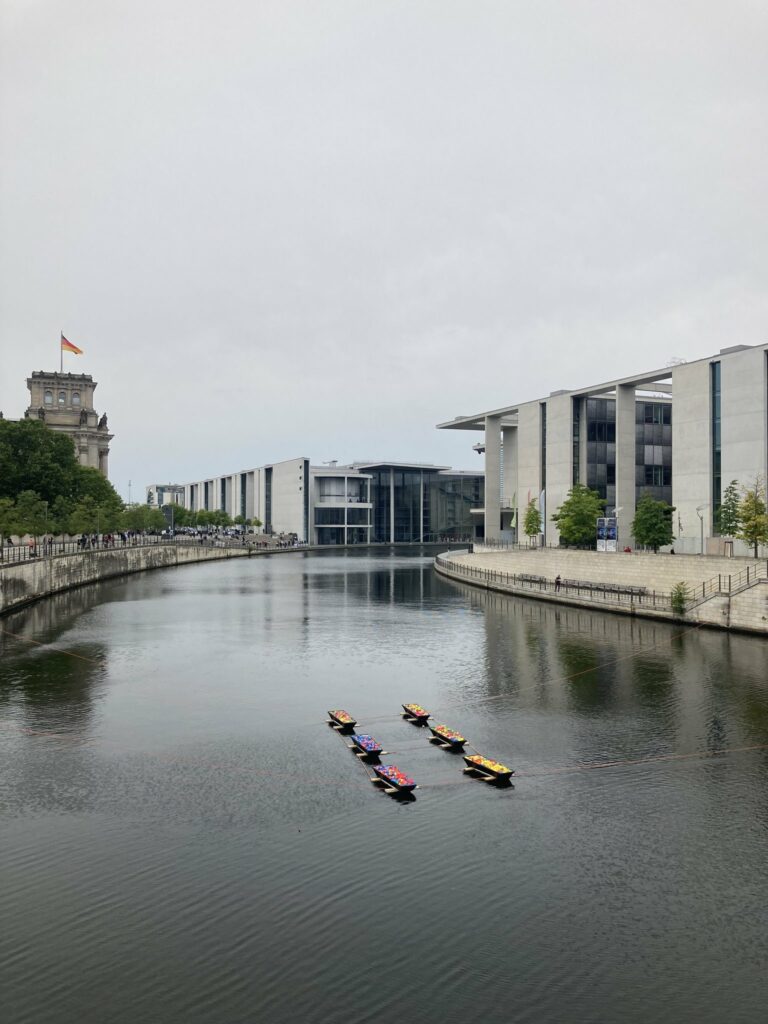
CommemorAction of the Pylos shipwreck in Berlin. Source: Alarm Phone
On 15-16 June, the Tunisian Coastguard conducted 59 operations, intercepting 1,806 individuals. Those intercepted risked expulsions to the desert. On land, 24 arrests were made, raids continued, and a big number of boats and engines was seized.
On 16 June, the Nadir found a distress case reported by Alarm Phone. The engine of the overcrowded boat was broken. The Nadir crew was able to provide the 62 people with rescue equipment and pulled the boat towards Lampedusa, until the Italian Coastguard arrived. On the same evening, the Nadir found and assisted another boat in distress at sea reported by Alarm Phone. The boat was unable to manoeuvre. Water and petrol had leaked inside.
On 17 June, Alarm Phone learned the horrific news that a sailing boat with about 70 people on board had capsized 120 miles off the Italian coast. Contrary to what the Italian Coastguard claimed in their press release, they were well aware of the distress case after our alert, not only after the Mayday of a French pleasure boat. Only 11 survivors and one dead body were found, all others remain missing.
On the same day, the Nadir crew found ten dead people in the lower deck of a boat. Alarm Phone had been alerted to this boat in distress, carrying about 60 people.
On 18 June, 48 people who had called Alarm Phone in distress were rescued by the Geo Barents.
On 19 June, Tunisia’s SAR area and TNMRCC (Tunisian Maritime Rescue Coordination Centre) have been officially declared and published.
On the same day, Libyan militias of the so-called Libyan coastguard brutally pulled back approximately 60 people, together with the merchant vessel Maridive.
On 20 June, the Humanity 1 rescued several people on two boats and people on a third boat were illegally forced back to Libya, as witnessed by Seabird. On this World Refugee Day, the Humanity 1 observed three more Libyan interceptions.
On 21 June, the Nadir reacted to a May Day Relay of the sailing vessel Trotamar III, which assisted about 60 people in distress. Nadir took over six people and brought them to Lampedusa.
On 22 June, the fast civil ship Aurora with the support of Seabird rescued 40 people who had alerted Alarm Phone and supported another 65 people, later rescued by the Italian Coastguard. All were brought to Lampedusa.
On 26 June, Alarm Phone was called by 48 people in distress south-east of Sicily but lost contact. One day later we learned that the people were taken on board an Italian Coastguard vessel and made it to Italy. Sadly, we received the information that on the second day at sea two of the people had died.

Map showing the position of the boat in distress. Source: Alarm Phone
On the same day, the Civil Court in Crotone handed down the final ruling on the legal action against the detention of the Humanity 1 in March. The detention was unlawful! Even more groundbreaking is the court’s finding that the Libyan rescue coordination centre and the so-called Libyan Coast Guard cannot be considered legitimate search and rescue actors in the Mediterranean.
On 28 June, another Italian court decided in the “Asso29 case” that Libya is not a safe place. The Ministries of Defense, Transport, the Presidency of the Council, the Captain of the Asso 29 and the shipping company Augusta Offshore were sentenced to compensate the damages of five appellants who were taken back to Libya by the Italian merchant ship in 2018.
On 29 June, an EU mission in Tripoli and for the first time in Benghazi focussed on migration and border management. The aim was to “evaluate the progress made by the Libyan authorities” on several important topics.
On 30 June, a fishing vessel, carrying people on the move, departed from Tobruk, eastern Libya and arrived in the Italian SAR area – the first big vessel more than one year after the Pylos shipwreck from 14 June 2023.